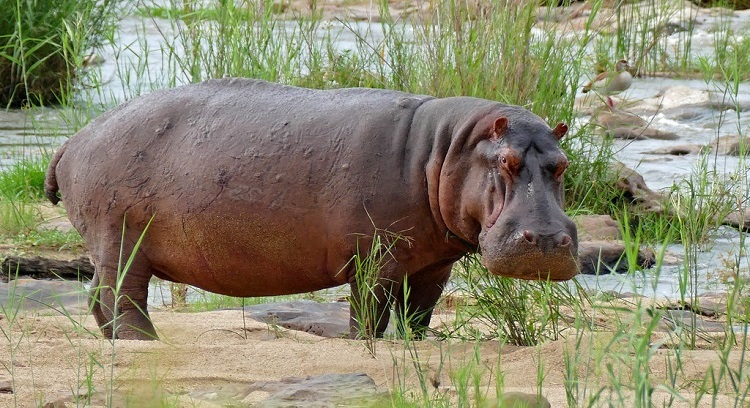Welcome to exploring the one animal on land that causes the most human deaths in Southern Africa. Dangerous, grumpy, and with the size and grit to back up its threats – the hippopotamus is an animal to be feared.
Go into its territory at your own risk because your very presence will cause annoyance of the highest order. As cute as it appears, the hippo is aggressive, has a bad temper, and doesn’t tolerate any disturbance to its peaceful wallowing.
Nevertheless, there are many more fascinating facts about the hippo that you may want to catch up on. And – you can do that right here!
Hippopotamus Etymology
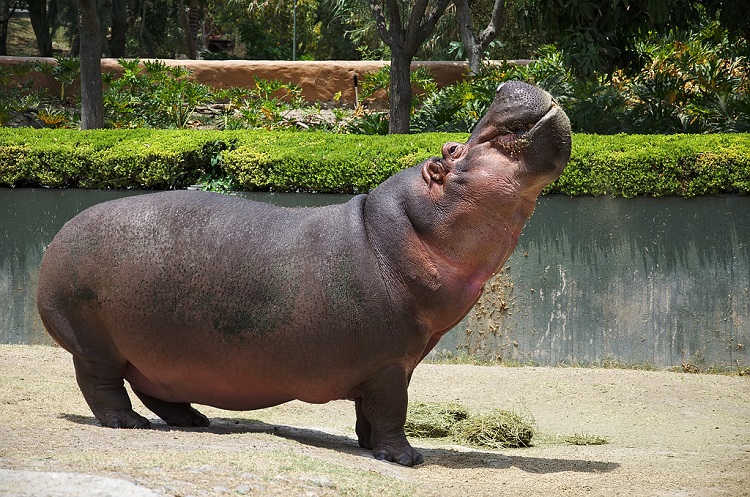
The word hippopotamus is Latin with Greek origins, meaning river horse. This term suits this animal well because it spends most of its life in the water. Where the horse part comes from is a bit of a mystery as it looks nothing like a horse. Nor does it have a temperament that is anything like a horse.
In fact, the hippo is one of the most dangerous animals on land. Be that as it may, the hippo is an intriguing animal worth a closer look.
Physical Appearance
Let’s explore more details about the physical appearance of a hippopotamus.
Hippo’s Skin
Like pygmy hippos, the closest relative of the hippo, both have purple-gray thick skin. Both species also look like they sweat blood. This blood sweat gives the hippo’s skin a brownish-pink coloring.
Because this animal does not have proper sweat glands, it uses this secretion to protect its sensitive skin from the sun, heat, and environment.
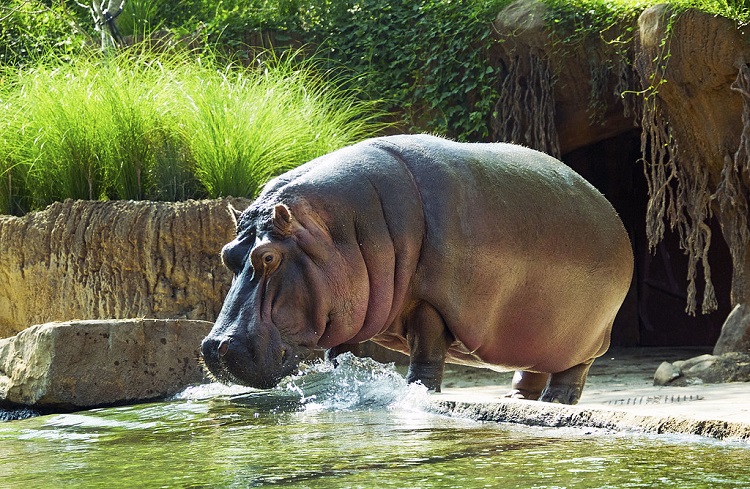
This “blood” secretion moisturizes the skin of these aquatic animals and also has antibacterial properties to protect against infection from disease-causing bacteria. Another function is that it prevents the hippo’s skin from becoming waterlogged.
Since the hippo’s skin is so delicate, it spends its days wallowing in rivers, mangroves, and water holes. Without this moisture, the hippopotamus amphibius won’t survive.
Hippo Weight
Adult males or hippo bulls reach an average weight of 3,300 pounds. Female hippos or cows tend to weigh about 2,900 pounds. The top male’s weight is almost five times the size of pygmy hippos.
How Tall Is a Hippo?
The hippopotamus amphibius grows between 4.3 and 5.4 feet at shoulder height. Its barrel-shaped body grows from 9.5 to 16.6 feet, and its tails reach 11 to 14 inches long.
Evolution and Classification
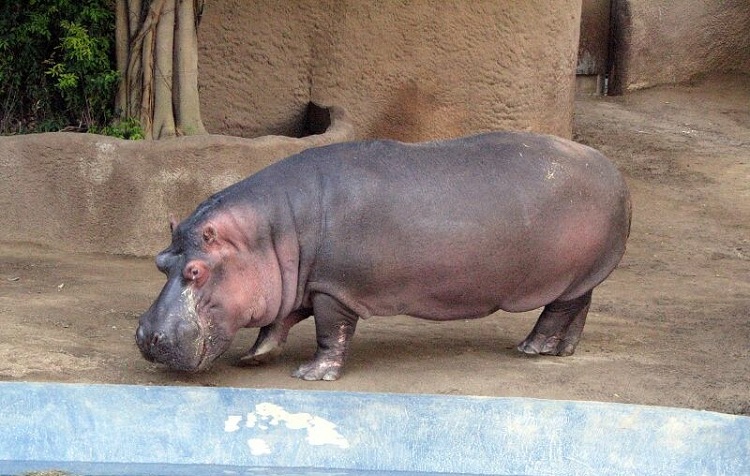
Despite what you may imagine, the closest living relative of the hippopotamus amphibious is not the tapir, a hog, or any other animal on land. In contrast, its closest relatives are whales and dolphins.
Types of Hippos
There is only one extant type of hippo which is the one that is native to sub-Saharan Africa. This animal is the common hippo, Nile hippo, or water horse.
Hippo Species
Researchers tested hippo samples from various regions and discovered notable DNA differences. These variations led to identifying five subspecies of the hippopotamus according to their geographical habitats and skull shapes.
Their physical appearances used to differ in terms of the shapes of their facial and head features. Other variations included the size of the hippo teeth and jaws. Although these classifications are not widely used, they consist of the following five subspecies:
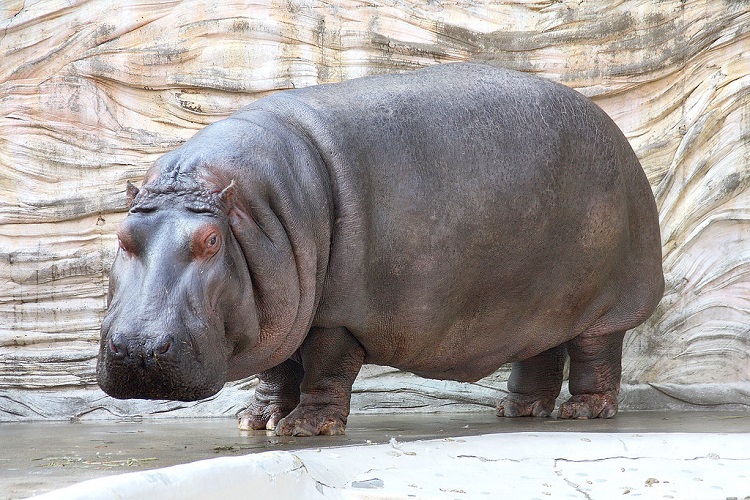
- H. a. amphibius – lives in Ethiopia, east Gambia, and Mozambique. It used to also live in Egypt but is now extinct in that region.
- H. a. kiboko – inhabits regions of Somalia and Kenya.
- H. a. capensis – native to South Africa and Zambia.
- H. a. tschadensis – inhabits the Niger and Chad.
- H. a. constrictus – this subspecies used to inhabit Namibia, Angola, and the southern section of the Democratic Republic of Congo.
Although often thought of as two species, the common hippo, and the pygmy hippo are separate species. Common hippos belong to the H. amphibious species, and the pygmy hippo belongs to the Choeropsis liberiensis species. These species are all part of the family Hippopotamidae.
Extinct Species
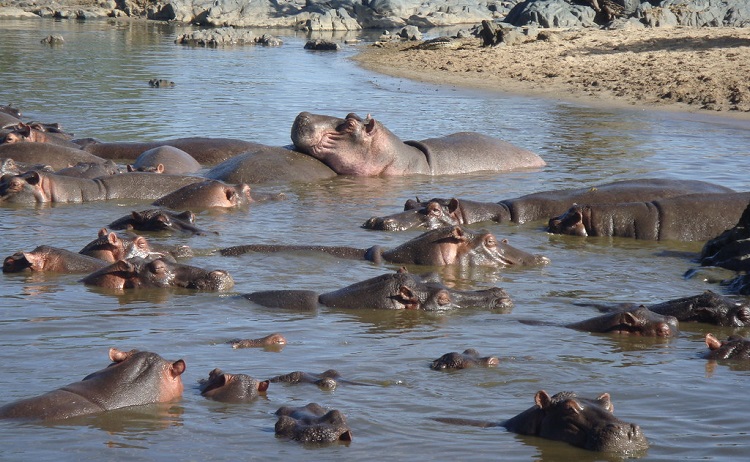
Malagasy hippos were also called the Madagascan pygmy hippopotamus or the Malagasy pygmy hippopotamus. Experts found fossil bones of this dwarf hippo (Hippopotamus madagascariensis), which went extinct around the 1500s.
It was one of three species in Madagascar that became extinct. The others two were Hippopotamus lemerlei and Hippopotamus laloumena. Rather than a type of pygmy hippo, all three were dwarf hippos due to developing in isolation.
Another extinct species is the Hippopotamus antiquus, native to the European regions during the Pleistocene epoch. Several species were also native to Mediterranean islands. These species became extinct during the Pleistocene epoch or the Holocene period.
They include the Hippopotamus creutzburgi of Crete, the Cyprus dwarf hippopotamus or Hippopotamus minor, the Hippopotamus melitensis of Malta, and the Hippopotamus pentlandi of Sicily.
Eurasian hippopotamuses went into extinction between 16,000 and 50,000 years ago. The hippopotamus gorgops was the biggest prehistoric hippo and a common semiaquatic ancestor of today’s hippos. It weighed up to 9,900 pounds and died out approximately 1.6 million years ago.
Hippos Population
Depending on what source you consult, estimates of hippo populations vary drastically. However, no matter where you look, their numbers are low, ranging from 115,000 to 148,000.
Characteristics and Adaptations of Hippopotamus
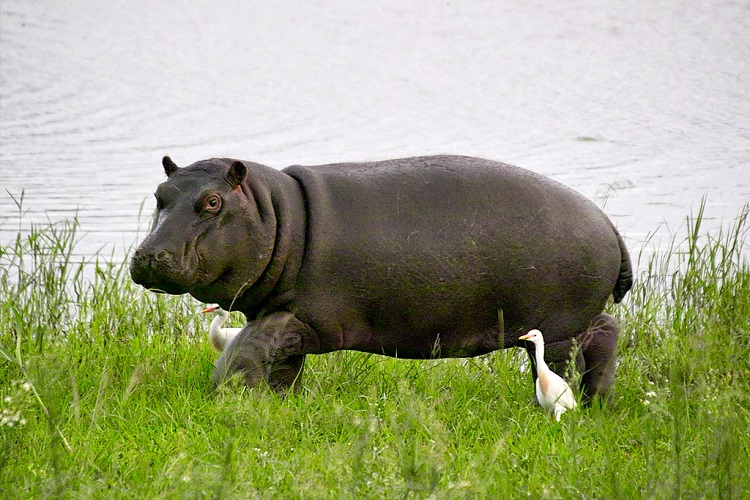
Hippos are the third biggest land animals behind some rhinoceros species and the elephant. The hippo is a megaherbivore. Other distinctive characteristics are that they are dangerous animals and highly territorial.
Hippopotamus amphibious are notable for their huge mouths, large tusks, and large canines. They have a long nose on an hour-glass shaped skull. Speaking of large, these semi-aquatic animals also have large bodies and short legs ending in four webbed toes.
Females stop growing at around 25 years, but males continue growing. Although their average weight is approximately 3,000 pounds, males can reach a maximum weight of almost 5,900 pounds.
Their average body length can be as much as 16.6 feet, including a tail length of up to 1.84 feet. Female and male hippos stand from 4.8 and 5.4 feet at the shoulder. The median length of their head and body is 10.8 to 11.3 feet.
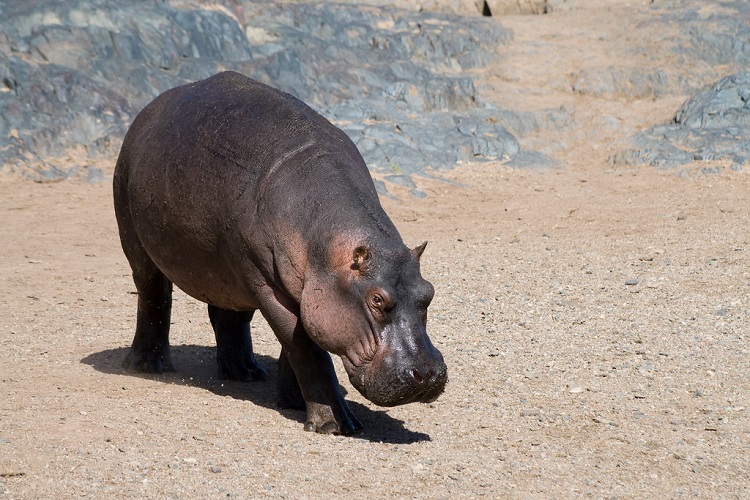
These animals are adapted to an aquatic lifestyle due to their dense bones and a low gravity center made possible by a graviportal skeleton. Small legs, compared to other megafauna and large bodies, mean they can sink to the bottom of water bodies like rivers and lakes, where they move easily.
When on land, these animals can gallop at 19 mph and trot quickly. Although this speed is not as fast as the cheetah at 70 mph, it is quite impressive for their body size and weight. The hippo may also not be able to jump like the cheetah, but it can climb steep banks. Despite looking rather portly, they carry little fat on their round bodies.
Hippo Facts
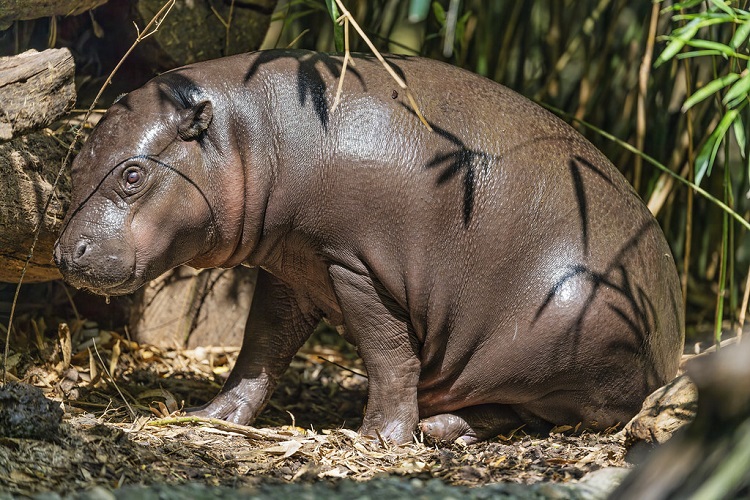
Below are some interesting facts about this larger-than-life animal:
How Long Can Hippos Hold Their Breath?
Most sources claim that hippos can hold their breath for five minutes underwater. Some sources say they can hold their breath for 30 minutes.
This claim probably refers to their sleep time when they automatically rise to the surface to breathe without waking up. As much as some people might like to think they can breathe underwater – they can’t.
Aggression and Dominance
Most wild animals are territorial and dangerous, but the adult hippo takes both these characteristics to new levels. They are the most dangerous animals in Africa, and the chances that they will kill you are almost 87%, whereas you stand a 25% chance of surviving a lion attack.
To put that in perspective, shark attacks are much lower at 25%. Besides, human deaths from hippos are suspected to range from 500 to 3,000 every year. In other words – stay away from hippos!
Hippopotamuses live in groups known as pods or herds. These herds consist of 40 to 200 hippos. When they aren’t wallowing in the water or mud pools, they poop in areas called middens. These middens mark their territory and send a clear message to other animals that they aren’t welcome in their space.
These middens are also a form of communication with other hippos. Also, the males poop and flap their tails rapidly from side to side, creating an unpleasant but effective poop spray in all directions.
This technique is just one more way they tell others to keep their distance, and who would want to challenge this dominance besides other male hippos?
Hippos’ Lifespan
Their average lifespan is 50 years in captivity and 40 years in the wild.
Where Do Hippos Live?
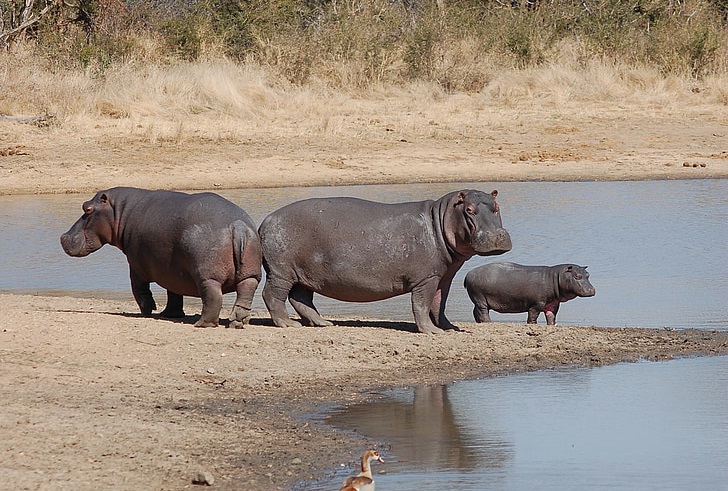
Hippopotamuses enjoy semi-aquatic environments like the cooling waters of lakes, swamps, and rivers near grasslands. Here, they can protect their skin in the water and have an additional food source on land.
Hippos love living in tropical or subtropical areas with warm and wet weather. Where they occupy dry regions, they must live near water. Pygmy hippos on the African continent live primarily in West Africa.
Even though hippopotamus amphibius can’t swim but bounce or walk through deep water, they are well-adapted to swamps. Their eyes, ears, and nostrils lie on their heads, so they spend their time immersed in water just with their faces above the surface.
They have a protective eye membrane for underwater foraging that ensures good vision. Common hippo even sleeps underwater because they have a buoyancy system that bobs them to the surface to breathe every few minutes. They don’t even need to wake up.
Hippo Range
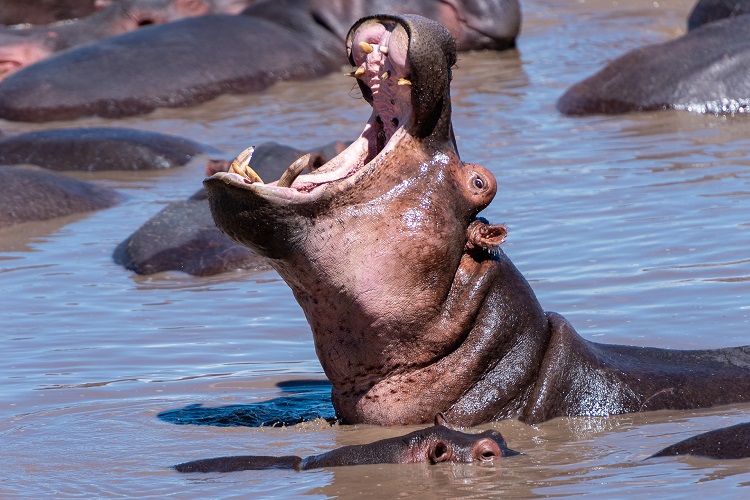
Hippopotamus amphibius has a confined population range in southern Africa. This range extends to Central Africa, East Africa, and West Africa – south of the Sahara desert.
However, the common hippo must not be confused with the pygmy hippopotamus in the wetlands or marshlands in West Africa. The hippopotamus population is also declining globally despite having inhabited large tracts of land in Asia and Europe in the past.
Hippos are vulnerable to habitat loss from urban and agricultural development and habitat destruction. This loss often means that you can only find the common hippo living in small herds in the wild or in zoos. In many cases, you can only find a small hippo population in a national park where they have some protection from poachers.
Hippo Diet
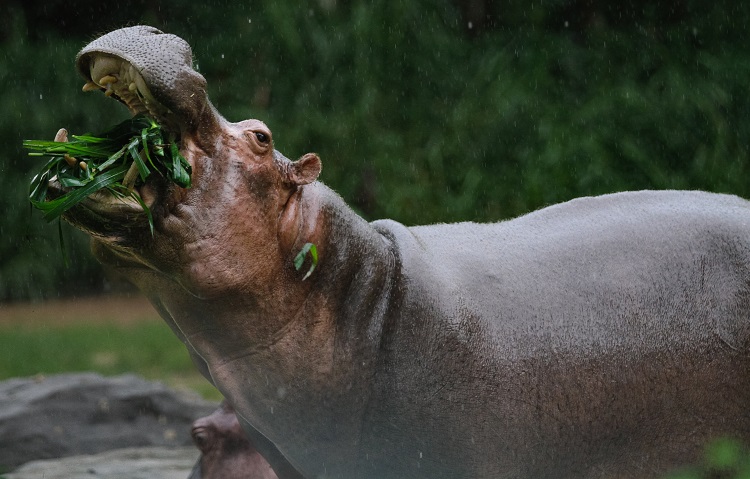
Hippos eat aquatic plants while in the water. At night, hippos emerge from their wet habitats for grazing. This proximity to hippo grass patches is why they live near grasslands.
When they come out of the water, they forage nearby or wander as much as three miles from their position to find fresh sweet grass shoots. They mark these paths with their dung to help them find their way during the night.
Besides various kinds of grass, these massive herbivores like eating fruit and leaves. If they find crops growing close to its territory, it may eat some of those or merely trample them.
Hippos may display predatory behavior at times and snack on an animal carcass. If food resources run low, they may even resort to cannibalism, although this behavior is extremely rare.
Behavior and Ecology
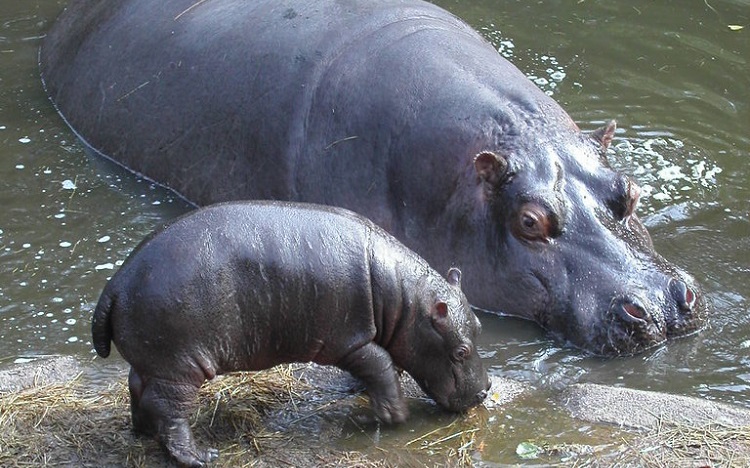
Now let’s look at their common behaviors and relationships with others:
Social Interaction
A large territorial bull will maintain breeding rights within the herd, although it tolerates bachelors. When fighting, the males open their mouths wide in a yawning threat display to discourage further challenges.
Should this behavior not deter aggression, they can use their incisors to block attacks and their canines as offensive weapons.
Because this large mammal is not sexually dimorphic, it is difficult to tell the sexes apart. But there are some clues about their social structures as the cows and bachelors create separate groups while the large territorial bull remains separate. They also emerge from the water to eat grass in distinct groups.
Pods can be as small or have more than 100 individuals. Despite close physical interactions, they don’t form close social bonds with sex and status, determining their group behavior.
Although territorial, these animals only create territories in the water and not on land. If their water source dries up, they search for another one.
Besides spreading muck in water and on land, these animals communicate with clicks in the water, which may be a form of echolocation. On the surface, they articulate with peculiar wheezing and honking noises beginning with squeals at high pitches and closing off with deep sounds.
They also produce bellows. Their cries travel great distances over land and beneath the water’s surface.
Reproduction
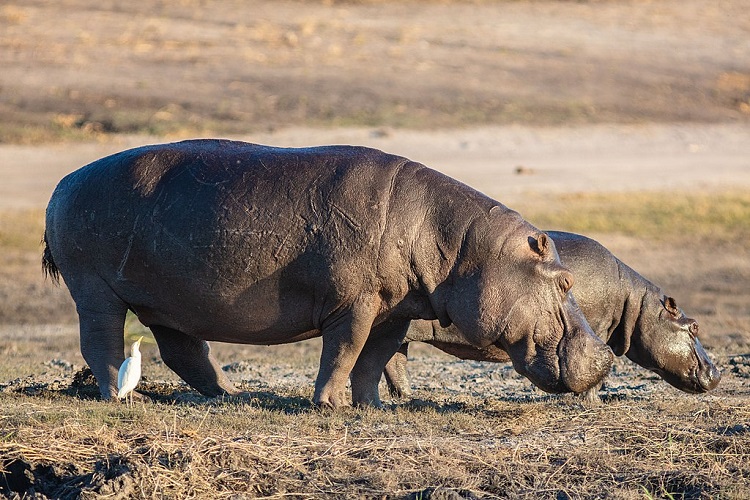
Cows start puberty between three and four years and reach sexual maturity between five and six. Males reach sexual maturity at about 7.5 years. Mating occurs in the water. The female’s head will emerge periodically to breathe.
Most conceptions and births take place in the wet season. Females’ gestation lasts about 243 days, and they will only ovulate again in another 17 months. She gives birth to one calf in isolation, only returning to the herd after ten to 14 days. The mother suckles her calf on her side on land or in the water.
These mammals also have nurseries where other females look after calves while mom is eating, but the chances are that she won’t be gone for long because moms are ferociously protective. The calves are fully weaned at about a year but will remain nearby until they’re about six or seven years old.
Interspecies Interaction

Adult hippos and their herds live among many other species. Many of these are carnivores like hyenas, lions, and crocodiles. These animals prey on calves but avoid the adults because they are too big and aggressive, especially the males.
But prides of lions will sometimes try to kill smaller or sick hippos. They may even try to take down adults, but this is the exception.
Crocodiles do the same by killing hippos that have been injured while fighting other males for mates. But hippos also react with extreme aggression when faced with these threats. Besides these animals, hippos go to cleaning stations for fish species to clean their teeth in exchange for food.
Hippo Predators
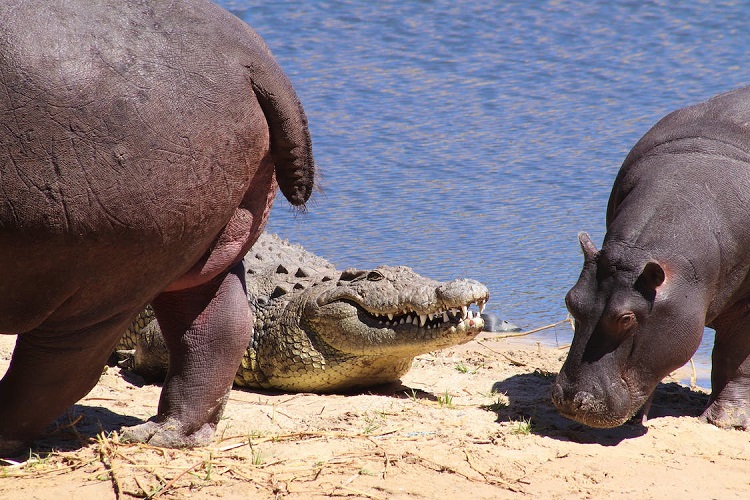
Lions, crocodiles, and hyenas prey on young hippos or adult males that have been injured in fights for mating rights. These predators can also prey on old hippos. Even African wild dogs in the Okavango Delta have been seen challenging other predators for hippo carcasses.
Hunting also threatens them because people prey on them for their meat and tusks for the ivory trade. Their horns are also popular on the black market for their traditional medicinal value.
Relation With Humans
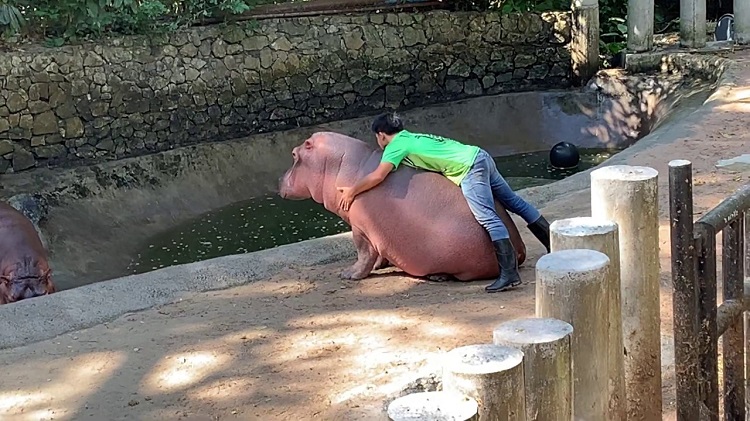
We’ve already shed some light on the dynamics of relationships with humans. Let’s learn about them further:
Importance in Culture
No – hippos don’t produce pink milk, so stop spreading that myth. Instead, stick to the ones the Egyptians did so well, like their god Set, who became a red hippo to challenge Horus but lost. Tawaret is another Egyptian goddess with the head of a hippo who symbolizes powerful motherly love.
Some tribes in the Niger Delta, like the ljaw, wore hippo masks when worshipping aquatic creatures. Other tribes, like the Chewa and the Nyau in southern Africa, also wore hippo masks for funeral rites.
The Zulu nation in South Africa reveres the hippo’s name in war chants.
The San people of southern Africa share how the Creator didn’t want to allow the hippos to live in the water because they might eat all the fish. This animal scatters its dung on land to show the Creator that it does not contain any fish bones.
Many other tales of hippos in the Madagascar films, the Hippo Polka dance, and poems (T.S. Eliot) reflect the influence of this animal on human culture.
Attacks on Humans
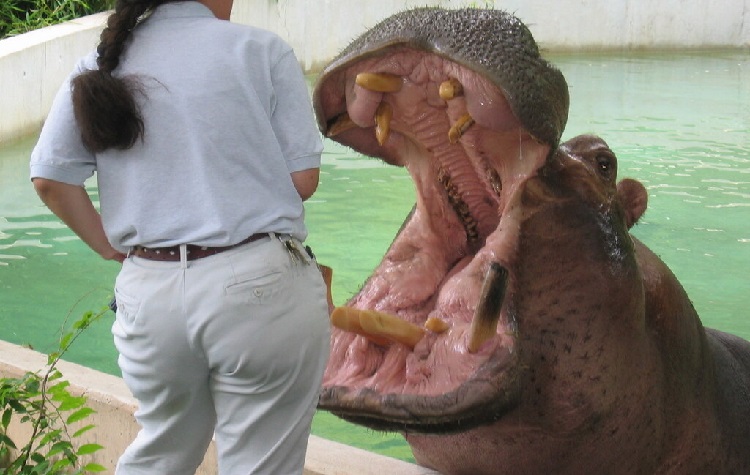
Hippos are aggressive and known to charge small boats frequently. They view humans as threats and react accordingly. Authorities estimate that hippos kill from 400 to 3,000 people annually.
In Captivity
Evidence shows that people first kept hippos in Hierakonpolis in Egypt in 3,500 BC. The London zoo was home to its first hippo, Obaysch, in 1850. He inspired the song “Hippopotamus Polka.”
More recently, the Cincinnati Zoo built an incredible enclosure for its hippos in 2015. It included a 3.5-inch-thick glass for their pool for underwater viewing. This pool was the site for the first underwater birth of a hippo in captivity.
Threats to Survival
Hippopotamus face several threats to their survival, primarily due to human activities. Habitat loss and degradation are the most significant threats, as wetlands and rivers, which are the natural habitats of hippos, are being destroyed for agriculture, urbanization, and infrastructure development.
The pollution of water sources by industrial and agricultural activities, as well as plastic waste, poses another hazard to their survival. Additionally, illegal poaching and hunting for their meat and ivory teeth, which are used for traditional medicines and souvenirs, have significantly reduced their populations.
Climate change is also a potential danger, as it could alter the water levels and temperatures in their habitats, affecting their feeding patterns and reproductive cycles. Without immediate conservation efforts, the hippopotamus faces an uncertain future.
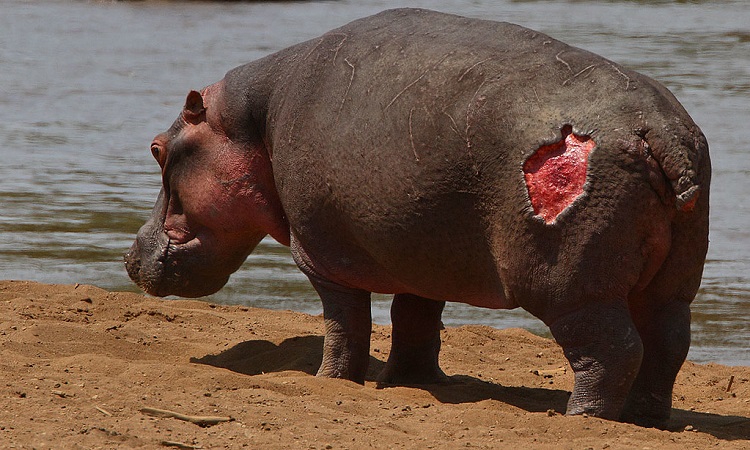
Are Hippos Endangered?
The IUCN lists the hippo as a vulnerable species.
Conservation Status
As stated above, this animal is steadily declining due to poaching. It displays decreasing numbers in its population from seven to 20% over the past decade. Some records show that the hippo population now comprises only 115,000 to 130,000 animals.
You can help raise awareness of their dwindling numbers by sharing your knowledge. Another way to help is by contributing to organizations like the Wildlife Conservation Society. They make signing up and donating a convenient process. In most cases, these donations are also tax-deductible.
Conclusion
People often think the pygmy hippo is the same as the common hippo because they have a common ancestor. They’re often surprised to learn that they are two hippo species. The pygmy hippo is small, reserved, isolated, and not aggressive, whereas the common hippo is a grumpy old soul.
Both species’ survival is threatened, although the pygmy hippo is on the endangered list. You can help by supporting organizations that promote global animal conservation


